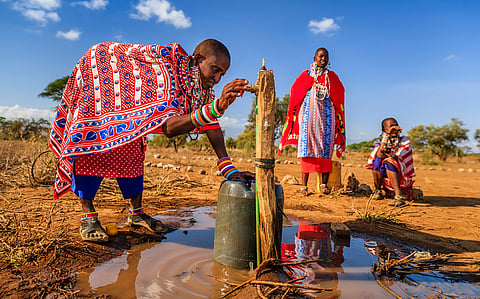

For free download, click here
Changes wrought by human-induced climate change on the global water cycle will have an adverse impact on Africa, according to the latest edition of New Delhi-based Centre for Science and Environment (CSE)’s annual publication.
For instance, high water stress caused by global warming will displace up to 700 million Africans by 2030, warned State of Africa’s Environment 2025, released in the Ethiopian capital of Addis Ababa on September 18, 2025.
The report also cited State of the Climate in Africa 2021, published jointly by WMO and the African Union Commission, which said water stress will also aggravate conflicts on the continent.
Global warming is causing extreme weather events such as lingering droughts and devastating floods that is hitting African communities, economies and ecosystems hard.
State of Africa’s Environment 2025 also pointed to the 2024 Global Water Monitor Report, released in January 2025.
The report warned that 2025 could bring further extreme weather events. Northern South America, southern Africa, northern Africa, Central Asia, parts of North America and Western Australia are likely to experience intense droughts. In contrast, regions such as the Sahel, Horn of Africa, Europe and most of Asia face heightened risks of flooding.
Glaciers, those storehouses of water, are also expected to decline in Africa in the face of warming.
Mount Kenya, Mount Kilimanjaro (Tanzania) and the Rwenzori mountains (Uganda) are retreating at a faster rate than the global average.
“Kilimanjaro could vanish by 2040 due to climate change, the WMO had warned in the “State of the Climate in Africa 2020”. But the existence of these glaciers in east Africa depends on the amount of future precipitation that falls on the region,” according to State of Africa’s Environment 2025.
It also sounded a warning on African lakes, which have shrunk. The total surface area of Lake Chad shrunk to 1,350 square kilometres in the 2000s, from 25, 000 sq km in the 1960s. Lake Chad, which is located in the Sahel region at the conjunction of Nigeria, Niger, Chad and Cameroon, is home to 17.4 million people. These countries of the Lake Chad basin are among the 10 least peaceful countries in Africa, according to the Global Terrorism Index report, 2020.
“The drying up of continental water bodies like Lake Chad has significant adverse impacts on the agricultural sector, ecosystems, biodiversity and socioeconomic development,” said Petteri Taalas, secretary general of WMO.
In West Africa, the WMO report of 2020 has attributed long-term decline in river flow to increase in temperature, drought, and increased water demand. Four out of five African countries are unlikely to have sustainably managed water resources by 2030, the report, which has a special focus on water, noted.
“Increasing demand and decreasing supply of water might worsen conflict, it said. This will result in Africa not being able to meet the United Nations mandated Sustainable Development Goals (SDG) by 2030. Going forward, it will be very difficult for the continent to achieve goals on sustainable development unless actions are taken to address water-related concerns, the report said. Poor progress on water security will impact at least three SDG goals — poverty alleviation (SDG 1), green energy (SDG 7) and disaster risk reduction (SDG 11),” stated State of Africa’s Environment 2025.
The UN-led “Global Water Security 2023 Assessment”, released during the UN 2023 Water Conference, found that all African nations were “water insecure” accounting for nearly half of the 114 such nations in the world.
Three of the five “critically water insecure” countries in the world are in Africa — Eritrea, Sudan and Ethiopia. Africa accounts for 22 per cent of the world’s critically water insecure population. In the African continent, 13 African countries have been assessed to be in the critically insecure category.
Sub-Saharan Africa was the world’s most water-stressed region between 2020 and 2021, found a survey published in the Lancet Planetary Health journal in November 2022. Nearly 36 per cent of the people surveyed in the region were water insecure, according to the report.
Overall, some 14.2 per cent of the respondents were water stressed. Countries in Sub-Saharan Africa, such as Cameroon (63.9 per cent) and Ethiopia (45 per cent), experienced the highest rates of water insecurity.